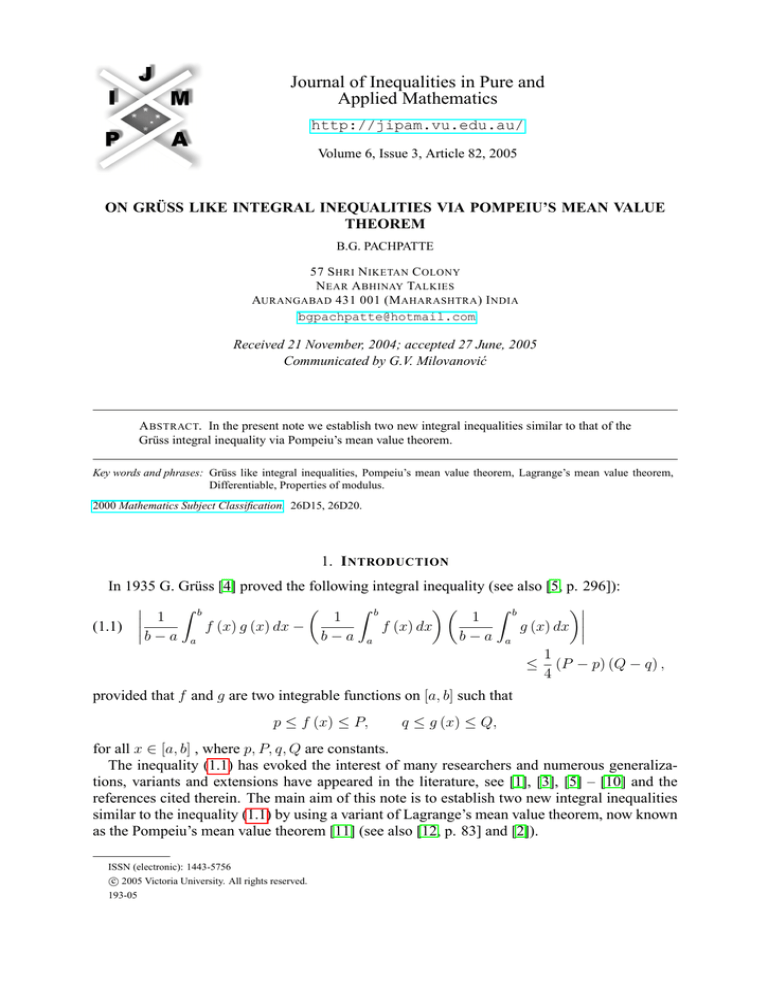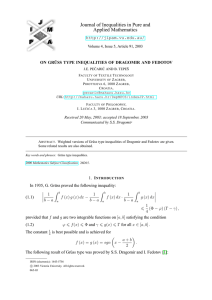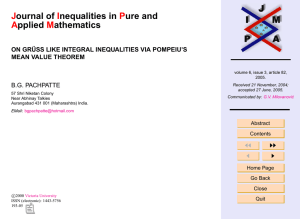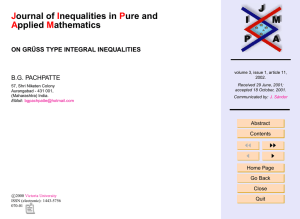
Journal of Inequalities in Pure and
Applied Mathematics
http://jipam.vu.edu.au/
Volume 6, Issue 3, Article 82, 2005
ON GRÜSS LIKE INTEGRAL INEQUALITIES VIA POMPEIU’S MEAN VALUE
THEOREM
B.G. PACHPATTE
57 S HRI N IKETAN C OLONY
N EAR A BHINAY TALKIES
AURANGABAD 431 001 (M AHARASHTRA ) I NDIA
bgpachpatte@hotmail.com
Received 21 November, 2004; accepted 27 June, 2005
Communicated by G.V. Milovanović
A BSTRACT. In the present note we establish two new integral inequalities similar to that of the
Grüss integral inequality via Pompeiu’s mean value theorem.
Key words and phrases: Grüss like integral inequalities, Pompeiu’s mean value theorem, Lagrange’s mean value theorem,
Differentiable, Properties of modulus.
2000 Mathematics Subject Classification. 26D15, 26D20.
1. I NTRODUCTION
In 1935 G. Grüss [4] proved the following integral inequality (see also [5, p. 296]):
Z b
Z b
Z b
1
1
1
(1.1) f (x) g (x) dx −
f (x) dx
g (x) dx b−a a
b−a a
b−a a
1
≤ (P − p) (Q − q) ,
4
provided that f and g are two integrable functions on [a, b] such that
p ≤ f (x) ≤ P,
q ≤ g (x) ≤ Q,
for all x ∈ [a, b] , where p, P, q, Q are constants.
The inequality (1.1) has evoked the interest of many researchers and numerous generalizations, variants and extensions have appeared in the literature, see [1], [3], [5] – [10] and the
references cited therein. The main aim of this note is to establish two new integral inequalities
similar to the inequality (1.1) by using a variant of Lagrange’s mean value theorem, now known
as the Pompeiu’s mean value theorem [11] (see also [12, p. 83] and [2]).
ISSN (electronic): 1443-5756
c 2005 Victoria University. All rights reserved.
193-05
2
B.G. PACHPATTE
2. S TATEMENT OF R ESULTS
In what follows, R and 0 denote the set of real numbers and derivative of a function respectively. For continuous functions p, q : [a, b] → R which are differentiable on (a, b), we use the
notations
Z b
Z b
Z b
1
p (x) q (x) dx − 2
G [p, q] =
p (x) dx
xq (x) dx
b − a2
a
a
a
Z b
Z b
+
q (x) dx
xp (x) dx ,
a
b
Z
b
a
Z
b
3
H [p, q] =
p (x) q (x) dx − 3
xp (x) dx
xq (x) dx ,
b − a3
a
a
a
to simplify the details of presentation and define kpk∞ = supt∈[a,b] |p (t)| .
In the proofs of our results we make use of the following theorem, which is a variant of the
well known Lagrange’s mean value theorem given by Pompeiu in [11] (see also [2, 12]).
Z
Theorem 2.1 (Pompeiu). For every real valued function f differentiable on an interval [a, b]
not containing 0 and for all pairs x1 6= x2 in [a, b] there exists a point c in (x1 , x2 ) such that
x1 f (x2 ) − x2 f (x1 )
= f (c) − cf 0 (c) .
x1 − x2
Our main result is given in the following theorem.
Theorem 2.2. Let f, g : [a, b] → R be continuous on [a, b] and differentiable on (a, b) with [a, b]
not containing 0. Then
Z b
1
x 0
(2.1)
|G [f, g]| ≤ kf − lf k∞
|g (x)| −
dx
2 a + b
a
Z b
1
x
0
dx,
+ kg − lg k∞
|f (x)| −
2 a + b
a
where l(t) = t, t ∈ [a, b].
A slight variant of Theorem 2.2 is embodied in the following theorem.
Theorem 2.3. Let f, g : [a, b] → R be continuous on [a, b] and differentiable on (a, b) with [a, b]
not containing 0. Then
(2.2)
|H [f, g]| ≤ kf − lf 0 k∞ kg − lg 0 k∞ |M | ,
where l(t) = t , t ∈ [a, b] and
(
(2.3)
M = (b − a) 1 −
2
(a + b)
3
· 2
4 a + ab + b2
3. P ROOFS OF T HEOREMS 2.2
)
AND
.
2.3
From the hypotheses of Theorems 2.2 and 2.3 and using Theorem 2.1 for t 6= x, x, t ∈ [a, b],
there exist points c and d between x and t such that
(3.1)
t f (x) − x f (t) = [f (c) − cf 0 (c)] (t − x) ,
(3.2)
t g (x) − x g (t) = [g (d) − dg 0 (d)] (t − x) .
J. Inequal. Pure and Appl. Math., 6(3) Art. 82, 2005
http://jipam.vu.edu.au/
G RÜSS L IKE I NTEGRAL I NEQUALITIES
3
Multiplying (3.1) and (3.2) by g(x) and f (x) respectively and adding the resulting identities we
have
(3.3) 2 t f (x) g (x) − x g (x) f (t) − x f (x) g (t)
= [f (c) − cf 0 (c)] (t − x) g (x) + [g (d) − dg 0 (d)] (t − x) f (x) .
Integrating both sides of (3.3) with respect to t over [a, b] we have
(3.4)
2
b −a
2
b
Z
f (x) g (x) − x g (x)
Z
b
f (t) dt − x f (x)
g (t) dt
a
a
b 2 − a2
= [f (c) − cf (c)]
g (x) − x g (x) (b − a)
2
2
b − a2
0
f (x) − x f (x) (b − a) .
+ [g (d) − dg (d)]
2
0
Now, integrating both sides of (3.4) with respect to x over [a, b] we have
(3.5)
2
b −a
2
Z
b
f (x) g (x) dx
Z b
Z b
Z b
Z b
−
f (t) dt
xg (x) dx −
g (t) dt
xf (x) dx
a
a
a
a
2
Z
Z b
(b − a2 ) b
0
= [f (c) − cf (c)]
g (x) dx − (b − a)
xg (x) dx
2
a
a
2
Z
Z b
(b − a2 ) b
0
+ [g (d) − dg (d)]
f (x) dx − (b − a)
xf (x) dx .
2
a
a
a
Rewriting (3.5) we have
Z
0
(3.6) G [f, g] = [f (c) − cf (c)]
b
g (x)
a
1
x
−
2 a+b
dx
b
Z
0
+ [g (d) − dg (d)]
f (x)
a
1
x
−
2 a+b
dx.
Using the properties of modulus, from (3.6) we have
0
Z
|G [f, g]| ≤ kf − lf k∞
a
b
1
x |g (x)| −
dx
2 a + b
0
Z
+ kg − lg k∞
a
b
1
x |f (x)| −
dx.
2 a + b
This completes the proof of Theorem 2.2.
Multiplying the left sides and right sides of (3.1) and (3.2) we get
(3.7) t2 f (x) g (x) − (xf (x)) (tg (t)) − (xg (x)) (tf (t)) + x2 f (t) g (t)
= [f (c) − cf 0 (c)] [g (d) − dg 0 (d)] (t − x)2 .
J. Inequal. Pure and Appl. Math., 6(3) Art. 82, 2005
http://jipam.vu.edu.au/
4
B.G. PACHPATTE
Integrating both sides of (3.7) with respect to t over [a, b] we have
Z b
Z b
Z b
(b3 − a3 )
2
(3.8)
f (x) g (x) − xf (x)
tg (t) dt − xg (x)
tf (t) dt + x
f (t) g (t) dt
3
a
a
a
3
(b − a3 )
2
2
2
0
0
= [f (c) − cf (c)] [g (d) − dg (d)]
− x b − a + x (b − a) .
3
Now, integrating both sides of (3.8) with respect to x over [a, b] we have
Z b
Z b
Z
(b3 − a3 ) b
(3.9)
f (x) g (x) dx −
xf (x) dx
tg (t) dt
3
a
a
a
Z b
Z b
Z
(b3 − a3 ) b
−
xg (x) dx
tf (t) dt +
f (t) g (t) dt
3
a
a
a
= [f (c) − cf 0 (c)] [g (d) − dg 0 (d)]
3
2
2
(b3 − a3 )
(b − a3 )
2
2 (b − a )
×
(b − a) − b − a
+ (b − a)
.
3
2
3
Rewriting (3.9) we have
(3.10)
H [f, g] = [f (c) − cf 0 (c)] [g (d) − dg 0 (d)] M.
Using the properties of modulus, from (3.10) we have
|H [f, g]| ≤ kf − lf 0 k∞ kg − lg 0 k∞ |M | .
The proof of Theorem 2.3 is complete.
R EFERENCES
[1] S.S. DRAGOMIR, Some integral inequalities of Grüss type, Indian J.Pure and Appl.Math., 31
(2000), 379–415.
[2] S.S. DRAGOMIR, An inequality of Ostrowski type via Pompeiu’s mean value theorem, RGMIA
Res. Rep. Coll., 6(suppl.)(2003), Art. 11.
[3] A.M. FINK, A treatise on Grüss inequality, Analytic and Geometric Inequalities and Applications,
Th.M. Rassias and H.M. Srivastava (eds.), Kluwer Academic Publishers, Dordrecht 1999, 93–113.
Rb
1
[4] G. GRÜSS, Über das maximum des absoluten Betrages von b−a
a f (x) g (x) dx
R
R
b
b
1
− (b−a)
2 a f (x) a g (x) dx, Math. Z., 39 (1935), 215–226.
[5] D.S. MITRINOVIĆ, J.E.PEČARIĆ AND A.M.FINK, Classical and New Inequalities in Analysis,
Kluwer Academic Publishers, Dordrecht, 1993.
[6] B.G. PACHPATTE, On Grüss type integral inequalities, J. Inequal.Pure and Appl. Math., 3(1)
(2002), Art. 11.
[7] B.G. PACHPATTE, On Trapezoid and Grüss like integral inequalities, Tamkang J. Math., 34(4)
(2003), 365–369.
[8] B.G. PACHPATTE, New weighted multivariate Grüss type inequalities, J. Inequal. Pure and Appl.
Math., 4(5) (2003), Art. 108.
[9] B.G. PACHPATTE, A note on Ostrowski and Grüss type discrete inequalities, Tamkang J.Math.,
35(1) (2004), 61–65.
[10] B.G. PACHPATTE, On Grüss type discrete inequalities, Math. Ineq. and Applics., 7(1) (2004),
13–17.
J. Inequal. Pure and Appl. Math., 6(3) Art. 82, 2005
http://jipam.vu.edu.au/
G RÜSS L IKE I NTEGRAL I NEQUALITIES
5
[11] D. POMPEIU, Sur une proposition analogue au théorème des accroissements finis, Mathematica
(Cluj, Romania), 22 (1946), 143–146.
[12] P.K. SAHOO AND T. RIEDEL, Mean Value Theorems and Functional Equations, World Scientific,
Singapore, New Jersey, London, Hong Kong, 2000.
J. Inequal. Pure and Appl. Math., 6(3) Art. 82, 2005
http://jipam.vu.edu.au/





